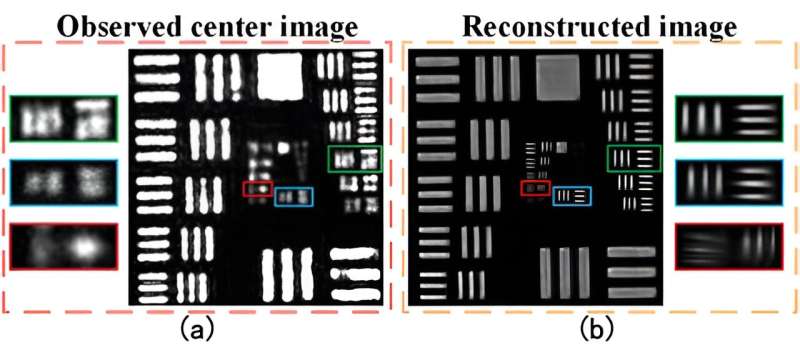
by Zhao Weiwei and Shi Dongfeng, Hefei Institutes of Physical Science, Chinese Academy of Sciences

Recently, a research team led by Prof. Wang Yingjian at Hefei Institutes of Physical Science (HFIPS) of Chinese Academy of Sciences (CAS), proposed an efficient method to implement Fourier ptychographic imaging technology for moving objects, which successfully achieved high-resolution imaging of moving objects at a distance.
The related results were published in Optics Express and featured as an Editor’s Pick.
Fourier ptychographic imaging technology combines phase recovery algorithms and synthetic aperture technology to achieve high-resolution imaging of objects, which can be applied to both microscopic and macroscopic imaging fields. However, its application has primarily focused on stationary objects, leaving a gap in high-resolution imaging of moving objects in practical scenarios.
In this research, by delving into the imaging principle and Fourier transform characteristics of lenses, the team discovered that object movement within the illumination area caused a phase shift in the Fraunhofer diffraction field, while leaving other information unaffected. Leveraging image registration techniques, this phase shift can be eliminated.
The proposed method employed a single small-aperture imaging camera to capture sequential low-resolution images of moving objects. Through registration, these sequential images were treated as if they were captured under stationary conditions. Subsequently, advanced algorithms enabled the reconstruction of high-resolution images equivalent to those obtained with large-aperture detection.

However, the use of extended coherent light sources introduces the challenge of speckle interference, which can result in the loss of object information.
To address this, researchers continuously collected multiple images of moving objects from the same camera position. By registering and averaging these images, the impact of speckle interference was mitigated, leading to improved image quality. In indoor experiments, a single small-aperture imaging camera successfully achieved high-resolution imaging of moving objects, yielding images equivalent to those obtained with 2.5 times larger aperture detection.
This research marked the first application of single-camera Fourier ptychographic imaging to moving objects, enabling high-resolution imaging in such scenarios. The findings represented a significant technological breakthrough, expanding the application potential of Fourier ptychographic imaging and opening up new possibilities in this field.
More information:
Runbo Jiang et al, Long-range Fourier ptychographic imaging of the dynamic object with a single camera, Optics Express (2023). DOI: 10.1364/OE.498226
Provided by
Hefei Institutes of Physical Science, Chinese Academy of Sciences
Citation:
Research enables high-resolution imaging of moving objects using Fourier ptychographic imaging (2023, December 8)
retrieved 8 December 2023
from https://phys.org/news/2023-12-enables-high-resolution-imaging-fourier-ptychographic.html
This document is subject to copyright. Apart from any fair dealing for the purpose of private study or research, no
part may be reproduced without the written permission. The content is provided for information purposes only.





